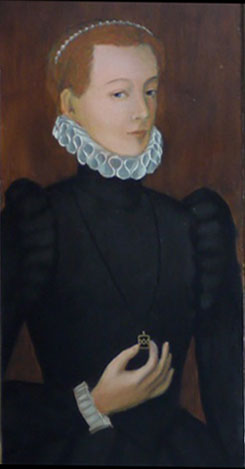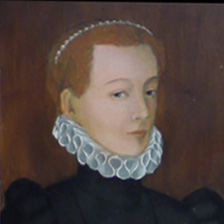What happened to “the four Marys” (Beaton, Seton, Fleming, and Livingston) after the death of their lady, Mary, Queen of Scots?
The four ‘Maries’ accompanied Mary Queen of Scots as a child to France in 1548 and remained her closest lifelong friends. Mary Beaton was the daughter of the head of Mary’s household, who accompanied her, and the others were the daughters of the three noble families closest to the Stewart Court. They had taken a vow of chastity following the death of Mary’s husband, Francis II, confirming that they would not marry until their mistress was also remarried.
Mary Beaton (or Bethune)
Mary Beaton was the daughter of John Beaton of Creich, from a distinguished family, who had traditionally fulfilled roles at Court and in Government. John had married Joanne de la Reyneville (or Gryssonier), one of the French Ladies-in-Waiting of Marie of Guise, Mary’s mother. The Beatons travelled to France with their two other children, David and Lucretia, and their son James was born while they were there. Mary Beaton was about eighteen months older than Mary and was considered the most classically beautiful of the four. On their return to Scotland in 1560 she was much admired by both George Buchanan and Thomas Randolph, the English ambassador to Scotland. On Valentine’s Day in 1564, Buchanan wrote the masque, Valentiana, in her honour. Although seventeen years older than her, Randolph had a soft spot for her, but his attention was not reciprocated and it fizzled out. Yet they played and won at Billiards together against Mary Queen of Scots and Darnley when they were first courting. When Mary’s Guise uncle, The Grand Prior Francis, died Beaton was delegated to bring the sad news to Mary as ‘the hardiest of the Maries’.
When Mary arranged for the Earl of Bothwell to marry Jean Gordon, the Earl of Huntly’s sister, she linked together the families of two of her most powerful supporters. Yet Jean had enjoyed a long running attachment to Sir Alexander Ogilvy 4th of Boyne, and she only reluctantly married Bothwell and was slow to consummate the marriage. Mary stepped in and arranged for Sir Alexander to marry Beaton two months later. There were three children of the marriage, James, Andrew and Robert. James, who inherited from his father as 5th of Boyne married Elizabeth Irvine of Drum.
Beaton died in about 1599, when Sir Alexander was at last able to remarry Jean Gordon, who was now the widow of the Earl of Sutherland. Sir Alexander died before 1606.

Mary Seton
Mary Seton was the daughter of George 4th Lord Seton by his second wife Mary Pyerres, another Lady in Waiting to Marie of Guise. Mary Seton was accompanied to France by a her young brother, James, who tragically died after drinking contaminated water at Ancenis on the Loire, before they reached the French Court at Orleans. After her father’s death in 1549, her mother returned to France to be with her and to seek a new husband, becoming Madame de Briante in 1554. Mary Seton was at least six months older than, but was probably the least glamorous of the four Maries, and was a similar height to Mary (5ft. 11 ins.) She never married, but was not without admirers although she seems to have been reluctant to break her vow of chastity.
Mary Seton remained in Mary’s service and was able to join her at Lochleven and during her period of house arrest in England, where she remained unpaid, with her own lady’s maid and groom for fifteen years. She was a noted hairdresser, a skill which she had learned in France, and Mary was dependent on her to maintain her rapidly thinning hair with wigs and hair pieces.
One of Seton’s admirers was Christopher, the second son of Sir Richard Norton, but he was executed for his part in the Northern Rising. When Andrew Bethune of Creich, a kinsman (probably uncle) of Mary Bethune, joined Mary’s household in England, he too courted Seton, but she was reluctant to marry someone below her distinguished rank in the Scottish nobility. Eventually in 1577, he travelled to France to release Seton from her vow of chastity but tragically died of smallpox as he was returning.
By 1583, Seton was broken in health, and she retired to France where she joined Mary’s aunt at the convent of St. Pierre des Dames in Reims. She lived on there in increasing penury until her death in 1616.
Mary Fleming
Mary Fleming was the daughter of Malcolm 3rd Lord Fleming, who had been killed at Pinkie Cleugh in 1547 and Janet Stewart, the illegitimate daughter of James IV. Although Fleming was the youngest of the Maries, being only marginally older than Mary, she was considered the senior of them because of her her Royal blood.
Fleming was accompanied to France by her widowed mother Janet Stewart, who accompanied the Royal party as their governess. She was extremely vivacious with nubile good looks and soon had an affair with Henry II, and unashamedly announced that she was pregnant. Queen Catherine de Medici collaborated with Henry’s long term mistress, Diane de Poitiers to ship Janet Stewart back to Scotland, where she gave birth to a son, Henry. After the death of Marie of Guise in 1560, Janet returned to France so that her son could be brought up with the other Royal children, but her daughter, Mary was about to return to Scotland with her mistress after the death of Francis II.
Fleming shared her mother’s nubile good looks and was considered by John Leslie to be ‘the flower of the flock’. George Buchanan wrote verses in her honour when she was chosen as ‘Queen of the Bean’ on Twelfth Night 1564, after finding a bean in her slice of a specially baked cake. The ‘Fair Fleming’ was chosen by fortune to be Queen. ‘Queen Flaminia’ was ‘Venus in beauty, Minerva in wit and Juno in worldly wealth. She enjoyed a two year flirtatious courtship with William Maitland of Lethington, and by all accounts had him wound round her little finger. He was fifteen years older than her, and Sir William Kirkcaldy of Grange reported her to be as suitable for Maitland ‘as I am to be Pope’. Yet they were married in 1566.
They had two children James born in 1568 and Margaret, who married Sir Robert Ker, 1st Earl of Roxburghe in 1587. When Edinburgh Castle fell in 1573, Maitland took poison to avoid facing a trial for treason. Mary Fleming soon remarried George Meldrum of Fyvie. Yet she was able to arrange the reversal of Maitland’s attainder in 1583, and her son James later wrote a defence of his father’s honour.
Mary Livingston
Mary Livingston was the daughter of Alexander 5th Lord Livingston and his wife Agnes Douglas, daughter of the 2nd Earl of Morton. She was a keen dancer and a good horse woman, being known as ‘Lusty’ by Mary and the other Maries. In 1564, she fell in love with John Sempill of Beltries, another keen dancer. Sempill was the illegitimate son of the Master of Sempill by his long term mistress, Elizabeth Carlile, an Englishwoman. This allowed Randolph to refer to him as ‘the happy Englishman’. The Livingston family were concerned at their daughter choosing an illegitimate son in marriage, but Mary encouraged them and paid for the wedding dress for the marriage on 6 March 1565. She also provided estates worth £500 per year, some out of the attainted lands of the Earl of Huntly at Strathbogie. When Strathbogie was restored to Huntly, the Livingstons were compensated with Little Cumbrae Island off the Clyde coast at Largs.
The couple remained unfailingly loyal to Mary. John tried to organise a plan for her escape from Lochleven. He later made a plan to assassinate the Earl of Morton, as Regent, but was caught and found guilty of treason. He managed to avoid a traitor’s execution, but was placed in Edinburgh Castle. Mary Livingston died in 1577, and although John Sempill was released in 1579, he died shortly after. They had four children. The eldest Sir James Sempill was educated at Stirling with James VI. He was a notable academic and, in 1599, assisted James in writing the Basilicon Doron, his treatise on divine right.

